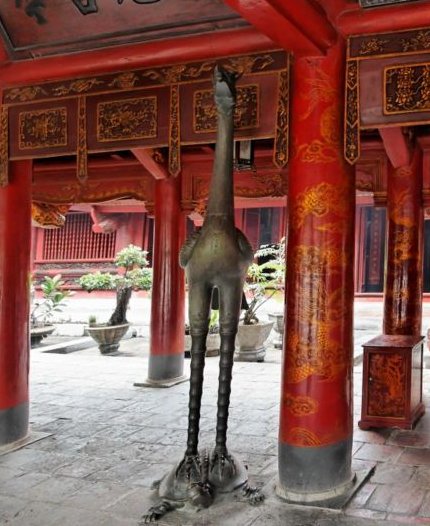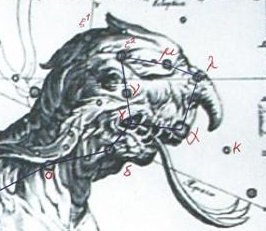158. Notably there is a resemblance between the left part in the peculiar niu glyph and the left part in the equally complicated Cb1-6, viz. a 'string' which is cut off before reaching the central figure:
Another resemblance is the composition with a kind of 'tree' in the center which 'balances' the figures at left and right.
Once upon a time Leo had been at the northern spring equinox with Orion at the winter solstice:
The Nose of the Lion (Al
Minhar al Asad) came 11 days before
Regulus, at the beginning of glyph line Ca6.
At the time of rongorongo this was in August
9 (*80 + 141 = 221 = the glyph number at
Ca6-1).
At the time when Betelgeuze
had been at 0h the Nose of the Lion would
have risen heliacally in day number 221
(August 9) - 88 = 133, or according to the
'crooked' Gregorian calendar in day number
133 + 4 = 137:
σ¹ Ursa Majoris
(137.0), κ
Cancri (137.3),
τ Cancri
(137.4),
ALSUHAIL = λ
Velorum
(137.5), σ² Ursa
Majoris (137.6),
τ Ursa Majoris
(137.7), ξ
Cancri (137.8)
ALPHARD = α
Hydrae
(142.3), ω
Leonis (142.6),
τ¹ Hydrae
(142.7)
ψ Velorum
(143.3),
ALTERF = λ
Leonis,
τ² Hydrae
(143.4), ξ
Leonis (143.5)
However,
counting from
the Julian equinox (4
days later than 0h) the
position of Al Minhar al
Asad would at the time
of Betelgeuze have come in
day number
221
(August 9) - 84 = 137
(respectively in day
number 137 + 4 = 141). ... Day 80 in the Gregorian
calendar was
March 21 and
right ascension
0h was there
because the Pope
had decided this
should be the
day of spring
equinox. ... Ecclesiastically, the
equinox is
reckoned to be
on 21 March
(even though the
equinox occurs,
astronomically
speaking, on 20
March in most
years) ... ... When the Pope
rearranged the
day for spring
equinox from
number 84
('March 25) to
number 80
(ºMarch 21) the
earlier Julian
structure was
buried, was
covered up (puo).
At the same time
the Pope
deliberately
avoided to
correct the flow
of Julian
calendar days
for what he may
have regarded as
4 unneccesary
leap days prior
to the Council
of Nicaea. Thus
his balance
sheet for days
was in order.
The day numbers
counted from the
equinox were
increased with 4
and this was
equal to
allowing the 4
'unneccessary'
leap days to
remain in place.
But he had moved
spring equinox
to a position
which was 4 days
too early
compared to the
ancient model
... These '4 unneccessary leap
days' (prior to
the Council of
Nicaea) were
equal in number
to the
precessional
distance in time
between the Pope
and the time of
rongorongo. The
Gregorian
calendar could
therefore be
easily
understood by
the Easter
Islanders. The
Pope had created
a 'crooked
calendar' but
since his time
the precession
had fixed it. ... When the Pope Gregory
XIII updated the
Julian calendar
he did not
revise what had
gone wrong
before 325 AD
(when the
Council of
Nicaea was
held). Thus the
stars were still
3-4 days 'out of
tune' compared
to the calendar
... the
Gregorian
'canoe' was
'crooked'. His
calendar was not
in perfect
alignment with
the ancient star
structure.
Because he had
avoided to
adjust with the
effects of the
precession
between the
creation of the
Julian calendar
and the Council
of Nicaea in 325
A.D. [The Julian
equinox was in
the 3rd month of
the year and in
its 25th day;
3-25.] Or as told in the language
of myth: ... There is a couple
residing in one
place named
Kui and
Fakataka
[meaning
Creating a Cycle].
After the couple
stay together
for a while
Fakataka is
pregnant. So
they go away
because they
wish to go to
another place -
they go. The
canoe goes and
goes, the wind
roars, the sea
churns, the
canoe sinks.
Kui expires
while
Fakataka
swims.
Fakataka
swims and swims,
reaching another
land. She goes
there and stays
on the upraised
reef in the
freshwater pools
on the reef, and
there delivers
her child, a boy
child. She gives
him the name
Taetagaloa
[meaning Not
Tagaroa].
When the baby is
born a golden
plover flies
over and alights
upon the reef.
(Kua fanau lā
te pepe kae lele
mai te tuli oi
tū mai i te papa).
And so the woman
thus names
various parts of
the child
beginning with
the name 'the
plover' (tuli):
neck (tuliulu),
elbow (tulilima),
knee (tulivae). They go inland at the land.
The child nursed
and tended grows
up, is able to
go and play.
Each day he now
goes off a bit
further away,
moving some
distance away
from the house,
and then returns
to their house.
So it goes on
and the child is
fully grown and
goes to play far
away from the
place where they
live. He goes
over to where
some work is
being done by a
father and son.
Likāvaka
is the name of
the father - a
canoe-builder,
while his son is
Kiukava.
Taetagaloa
goes right over
there and steps
forward to the
stern of the
canoe saying -
his words are
these: 'The
canoe is
crooked.' (kalo
ki ama).
Instantly
Likāvaka is
enraged at the
words of the
child.
Likāvaka
says: 'Who the
hell are you to
come and tell me
that the canoe
is crooked?'
Taetagaloa
replies: 'Come
and stand over
here and see
that the canoe
is crooked.'
Likāvaka
goes over and
stands right at
the place
Taetagaloa
told him to at
the stern of the
canoe.
Looking forward,
Taetagaloa
is right, the
canoe is
crooked. He
slices through
all the lashings
of the canoe to
straighten the
timbers. He
realigns the
timbers. First
he must again
position the
supports, then
place the
timbers
correctly in
them, but
Kuikava the
son of
Likāvaka
goes over and
stands upon one
support. His
father
Likāvaka
rushes right
over and strikes
his son
Kuikava with
his adze. Thus
Kuikava
dies.
Taetagaloa
goes over at
once and brings
the son of
Likāvaka,
Kuikava,
back to life.
Then he again
aligns the
supports
correctly and
helps
Likāvaka in
building the
canoe. Working
working it is
finished
...
Huri
1. To
turn (vt.),
to
overthrow,
to
knock down:
huri
moai,
the
overthrowing
of the
statues from
their ahus
during the
period of
decadence on
the island.
2.
To
pour a
liquid from
a container:
ka
huri mai te
vai,
pour me some
water. 3. To
end a
lament, a
mourning:
he huri i te
tagi, ina
ekó tagi
hakaou,
with this
the mourning
(for the
deceased) is
over, there
shall be no
more crying.
4. New
shoot of
banana:
huri maîka.
Vanaga.
1. Stem. P
Mgv.:
huri, a
banana
shoot. Mq.:
hui,
shoot,
scion. 2. To
turn over,
to be turned
over onto
another
side, to
bend, to
lean, to
warp;
huri ke,
to change,
to decant;
tae huri
ke,
invariable;
huri ke
tahaga no
mai, to
change as
the wind;
tae huri,
immovable;
e ko huri
ke,
infallible;
huhuri,
rolling;
hakahuri,
to turn
over;
hakahuri ke,
to divine. P
Pau.:
huri, to
turn. Mgv.:
huri,
uri,
to turn on
one side, to
roll, to
turn upside
down, to
reverse.
Mq.: hui,
to turn, to
reverse. 3.
To throw, to
shoot. 4. To
water, to
wet. 5. To
hollow out.
Hurihuri:
1. Wrath,
anger;
kokoma
hurihuri,
animosity,
spite,
wrath, fury,
hate,
enmity,
irritable,
quick
tempered, to
feel
offended, to
resent, to
pester;
kokoma
hurihuri ke,
to be in a
rage. 2. (huri
4)
hurihuri
titi, to
fill up. 3.
To polish.
4. (uriuri).
Hurikea,
to
transfigure,
to
transform.
Churchill.
Mq. huri,
resemblance.
Sa.:
foliga,
to resemble.
Churchill.
KAE UH
(Roof) = ο
Aquarii
(334.0),
AL KURHAH =
ξ Cephei
(334.4),
SADALMELIK
= α Aquarii,
AL DHANAB =
λ Gruis
(334.6), ι
Aquarii, ν
Pegasi
(334.7)
ε
Oct.
(338.1),
ρ Aquarii
(338.2),
2/365 Lac.
(338.5),
SADACHBIA
= γ Aquarii
(338.6), π
Gruis
(338.9)
10h (152.2)
AL JABHAH =
η Leonis
(152.4),
REGULUS
= α Leonis
(152.7)
Probably Leo was the
traditional place
for the beginning of
summer heat. Once
upon a time the
year could have begun
there:
... Midsummer is the
flowering season of
the oak, which is
the tree of
endurance and
triumph, and like
the ash is said to
'court the lightning
flash'. Its roots
are believed to
extend as deep
underground as its
branches rise in the
air - Virgil
mentions this -
which makes it
emblematic of a god
whose law runs both
in Heaven and in the
Underworld ... The
month, which takes
its name from
Juppiter the
oak-god, begins on
June 10th and ends
of July 7th. Midway
comes St. John's
Day, June 24th, the
day on which the
oak-king was
sacrificially burned
alive. The Celtic
year was divided
into two halves with
the second half
beginning in July,
apparently after a
seven-day wake, or
funeral feast, in
the oak-king's
honour
...
At the time of
Betelgeuze the Nose
of the Lion would
have risen
heliacally in day
number 133 - 84 = 49
(= 7 * 7) after the Julian
equinox, which at
the time of
rongorongo
corresponded to May
13 (133, *53 = 49 +
4) =
August 9 (221, *141
= 137 + 4) - 88.
In Roman times Al
Minhar al Asad would
have risen
heliacally in day
221 - 27 = 194
('July 13), with
Regulus in day 194 +
11 = 205 ('July 24)
which was a month
after St John's Day
(175 = 350 / 2).
At the time of
Bharani, 41 - 27 = 14
precessional days
earlier, Regulus
would have risen
with the Sun in day
205 - 14 = 191
("July 10) with the
Nose of the Lion in
day 180 (= 191 -
11).
According to
the Gregorian
calendar St John's
day was number 175
and we would have to move
further back in time
if the Nose of the
Lion should coincide
with day 161 (June
10th).
When Alcyone (*56)
had risen with the
Sun at 0h this was
56 - 41 = 15 precessional days
earlier than the
time of Bharani
(*41). The
Lion's Nose would
then have risen
heliacally
approximately in day
180 - 15 = 165 with
Regulus around day
165 + 11 = 176.
If
the year
should begin at
the Little King Regulus,
at 10h, then the
rest of the stars
would come later,
for instance Mira.
The similarity
between Ca6-11 and
Cb1-6 could have
been intended to make
this clear, because
the living spirit (manu
rere) of Mira
was also at Ca2-7 (→
27) at the throat of
the Sea Beast:
... Mira
also known
as
Omicron
Ceti
(ο Ceti,
ο
Cet), is a
red giant
star
estimated
200-400
light years
away in the
constellation
Cetus. Mira
is a binary
star,
consisting
of the red
giant Mira A
along with
Mira B. Mira
A is also an
oscillating
variable
star and was
the first
non-supernova
variable
star
discovered,
with the
possible
exception of
Algol. Apart
from the
unusual Eta
Carinae,
Mira is the
brightest
periodic
variable in
the sky that
is not
visible to
the naked
eye for part
of its cycle
...
|
|||||||||||||||||||||||||||||||||||||||||||||||||||||||||||||||||||||||||||||||||||||||||||||||||||||||||||||||||||||||||||||||||||||||||||||||||||||||||||||||||||||||||||||||||||||||||||||||||||||||||||||||||||||||||||||||||||||||||||||||||||||||||||||||||



.jpg)












